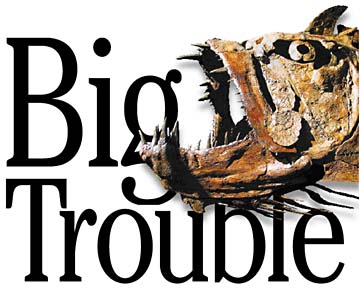
BURL BURLINGAME / BBURLINGAME@STARBULLETIN.COM
Exhibit manager Kathleen Izon would be a mere pupu for the giant shark Megalodon, whose jaws are part of the "Savage Ancient Seas" exhibition opening Saturday at Bishop Museum. Below is the skull of the prehistoric fish Xiphactinus.
Fossils of epic proportions
take over Bishop Museum
n ancient maps, when the world was still incomplete, cartographers labeled faraway seas with the legend: Here Be Dragons.
They weren't wrong but timing is everything. The seas did swarm with savage dragons, but it was 100 million years ago. Probably. Strange, big things do wash up on the beach once in a while. When you look at the ocean, you're only seeing the top of it, and who's to say that a dragon or two might not still be out there?
These musings splash to the surface in the new traveling exhibit "Savage Ancient Seas," opening this weekend at Bishop Museum. Hawaii is the only state without a permanent dinosaur exhibit, so these occasional exhibitions always draw enthusiastic crowds.
This time, however, in addition to the bright-eyed kids, science-minded adults and armchair adventurers, "Savage Ancient Seas" may hook fishermen as well. These are the big ones that got away.
Bishop Museum exhibit manager Kathleen Izon stands in the jaws of prehistoric shark Megalodon and, even with arms stretched wide, cannot touch the mandible. The jagged teeth are the size of Frisbees and unreel from the jaw like a vicious threshing machine.
"I wouldn't even be a snack," Izon says. "Imagine!"
The exhibit was developed by Triebold Paleontology Inc., an independent company engaged in finding, casting and displaying vertebrate fossils. Their molding and casting facility is in Valley City, N.D., and their business office and preparation laboratory is in Woodland Park, Colo.
JERRY BURGESS
Artwork by Jerry Burgess will also be on view.
The fossils in this exhibit were primarily collected in Kansas, which, in the late Cretaceous Period, was a warm shallow sea writhing with huge carnivorous marine reptiles -- we're talking double-hinged jaws, teeth in the middle of their palates, long, long necks, a frenzy of flashing flippers and slashing teeth. Above it all sailed hollow-boned pteradons, batlike creatures with rudders growing out of their heads.
The exhibit fills the Castle Memorial Building. "A couple of years in advance, we have to get the exhibit specifications to make sure everything will fit," said Izon. "The folks at Triebold come with the exhibit to make sure it's assembled and hung properly, to make sure the head is on the right end."
She isn't kidding. One of the central creatures is long-necked Elasmosaurus, legendary in the history of paleontology. Discovered in Kansas in 1867, it kicked off the "Fossil Wars" of the late 19th century. Overly enthusiastic scientist Edward Drinker Cope's description of the animal placed the head at the tip of the tail, and it was published before he could stop the presses. Rival collector Othniel Charles Marsh gleefully pointed out this mistake to Cope's embarrassment, and a bitter rivalry began that lasted decades. Their field teams scoured Western America in an intense competition for spectacular fossils. Many of the dinosaurs we know and love today were discovered because of this brutal competition.
The Elasmosaurus snakes through the gallery overhead, a kind of slender, paddle-footed plesiosaur -- and yes, the Loch Ness Monster is supposedly related -- while nearby, a snarky, 45-foot mosasaur called Tylosaurus bares its teeth, and swimming placidly in the central well gallery is a Volkswagen Beetle-size turtle called Archelon.
BURL BURLINGAME / BBURLINGAME@STARBULLETIN.COM
Jerry Burgess' artwork sums up life in our "Savage Ancient Seas."
MOST OF THE creatures are in their skeletal form, mounted by Triebold in swimming poses, like something out of a fishy nightmare. A school of five Pachyrhizodus, a scarily huge-mouthed Xiphactinus and a wriggling, toothy Clidastes turn the gallery into a prehistoric aquarium.
"It's the massive size of these things that intrigues people, I think," says Izon. "It makes one wonder, How would I survive if I lived in that period? Everything about dinosaurs is such a mystery. How did they live, how did they die, what did they eat ... When people start speculating, they on the path to scientific deduction."
Clidastes, a "small" mosasaur -- only about 12 feet long -- is one of the creatures re-created and re-fleshed as a life-size model, and it looks like an unholy mating between a moray eel and a Chinese dragon. In a case, there's a life casting of a prehistoric lobe-finned coelacanth.
BURL BURLINGAME / BBURLINGAME@STARBULLETIN.COM
An example of a fosilized Tylosaurus that is also part of the exhibition opening Saturday at Bishop Museum.
Yes, a life casting. Thought to be extinct for a hundred million years, coelacanths turned up off Madagascar in the 1930s to the amazement of paleontologists. They were even more amazed to discover that coelacanths occasionally show up in Asian fish markets.
They reportedly taste terrible.
'Savage Ancient Seas'
Where: Bishop Museum Castle Hall, 1525 Bernice St.When: Opens Saturday, continuing 9 a.m. to 5 p.m. daily through April 18
Admission: $14.95 for adults; 11.95 for ages 4 through 12; free for members
Call: 847-3511 or visit www.bishopmuseum.org
Also: The museum hosts its monthly Family Sunday on Feb. 15, with food, entertainment, activities and crafts, plus admission to the museum's newest exhibits, "Remains of a Rainbow," "Savage Ancient Seas," "Lono," and "Flying the Child's Hope." The fun runs from 9 a.m. to 5 p.m. on the Great Lawn. Admission is $3 per person (under 4 admitted free).
Click for online
calendars and events.





